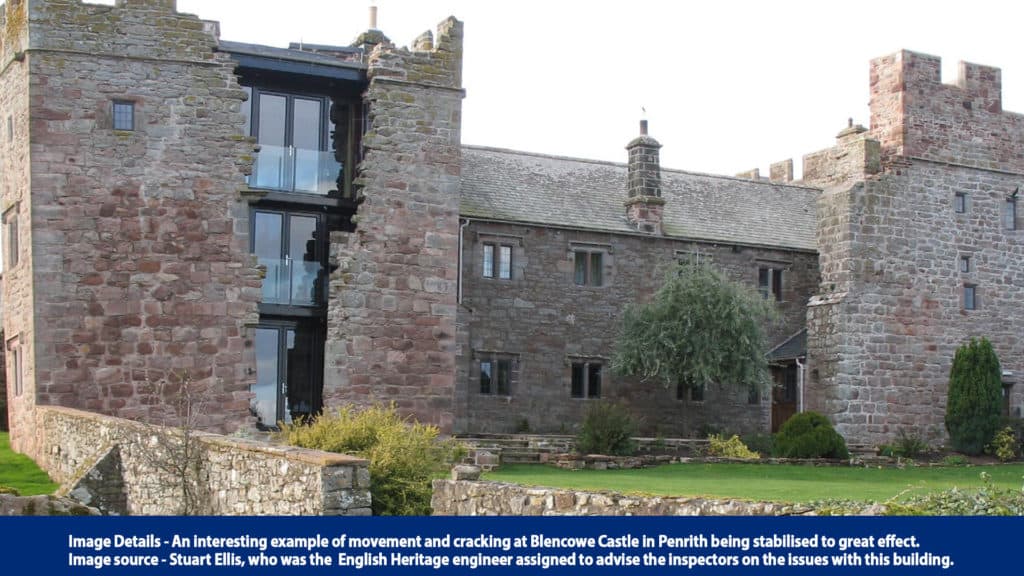
15 May 2020
Share
Is your house cracking up?
Thoughts on building movement from a Conservation Engineer
When first noticing a crack in your house, your natural reaction might be initial panic followed by a rush of questions… Is my house safe? Can it be repaired? How much will it cost? Am I insured?
As with many such questions the answer is ‘It depends!’
In newly constructed buildings, cracks often appear as the building ‘settles-in’ while the newly applied load compresses the underlying ground. Cracks also form when new materials dry and shrink as they become used to their domestic environment. The cracks rarely present a structural problem and after initial making-good works will usually not return.
An important difference between modern forms of construction and traditional or historic forms of construction is the way in which they deal with moisture. While modern buildings incorporate barriers to passage of moisture, traditionally constructed buildings differ in the way that their materials are assembled and combined to actively draw moisture away and encourage it to evaporate.
In older buildings, despite having ‘settled-in’ many years previously, the formation of new cracks is not uncommon. Many cracks – such as detaching wall plaster or ceiling surfaces -are not necessarily caused by structural movement or damage to the underlying structure. However, they may be indicative of unwelcome water or moisture ingress that may have already caused or will lead to future structural damage. Commonly, significant changes to an established equilibrium can cause moment that may lead to the formation of fresh cracks.
Perhaps the most important question to ask when first considering the source of a newly observed defect in an older property is ‘What has changed, recently?’ – which may mean in the last decade.
Ask questions like …
- Is the house being used differently?
- Has central heating been installed or turned up higher than usual?
- Has the outside been painted with impermeable paint?
- Has the masonry been pointed – in impermeable cement rich mortar, rather than permeable lime?
- Have there been any water leaks?
- Are the gutters blocked?
- Are the drains blocked or pipes cracked?
- Is the water supply leaking?
- Is the room above overloaded -perhaps with stored books or a large marble tiled bath?
- Has a large tree been allowed to grow near the house?
- Are shrub roots undermining the walls?
Observe the pattern of cracking – are they vertical, horizontal or stepped perhaps? Determine where the cracks originate. Measure whether the cracks are of constant width or are tapered. Are the cracks associated with any distortion in the shape of the building? The combined observations will often point to the source of movement and indicate a potential underlying reason.
Stepped or a diagonal pattern of cracks in walls or those extending away from corners of window openings might be associated with differential movement – perhaps due to foundation settlement; decay of a built-in timber backing-lintol; or perhaps expansive rusting of some built-in metalwork.
Horizontal cracks may be combined with bulging or leaning walls. With distortion perhaps due to a lack of restraint; the deterioration of a built-in timber; or even expansive rusting of hoop-iron (sometimes used as bed joint reinforcement). Outward leaning or bulging walls may be also associated with rotation of weakened foundations, outward thrust or spread from deflecting or failing roof systems or lack of ties at intermediate floor levels. Chimneys sometimes lean due to expansive reaction of smoke gas with mortars and moisture (typically leaning away from prevailing wind and rains).
Initial questions and observations will usually indicate the location of at least one potential problem and also the root cause of the problem. Further investigation by a suitably experienced conservation engineer can include non-destructive techniques such as thermal imaging or radar scanning and then targeted opening up works. Movement monitoring and sometimes ground or drain investigations will be needed to confirm the suspected cause and to inform the nature and extent of remedial repairs.
Understanding the root cause of a problem is essential. There is no point replacing a decayed timber if the causal water leak is not addressed! Equally, it is important to determine whether the root cause is still active. If a leaking drain has been repaired and the foundations are no longer settling, why underpin?
In older buildings, which are often founded on shallow footings and built of more flexible traditional materials, ongoing cyclical movement of the building with swelling and shrinkage of underlying soils is not unusual. This movement sometimes results in cracks, but these are rarely serious and often open and close with the seasons. Filling them can interrupt the cycle and cause a ratcheting effect, that can incorrectly be attributed to progressive foundation settlement. Monitoring can reveal such patterns. As an alternative to undertaking intrusive and costly underpinning works, such monitoring can justify the use of a soft flexible lime-mortar filler that simply excludes water.
While the ultimate conservation engineering goal would be to prove that no intervention is required –sometimes requiring appreciable effort- the experienced conservation engineer will use a range of specialist materials, products and techniques to develop the most appropriate solution.
Appropriate solutions will usually align with a few of the following, sometimes contradictory, aims. To undertake a minimum amount of works, only when necessary, with minimal disturbance and maximum retention of historic fabric. Repairs should go with the grain of the building, sometimes concealed, sometimes on display, and be recognisable as a repair when seen.
Before embarking on any works, even early stage investigations, it is always worth contacting your insurer to check your policy cover. The insurance company may have preferred engineers for Listed Building repair works or have particular requirements, but often will work together with the engineer of your choice.
As the conservation minded-structural solution usually seeks to minimise the amount and extent of repair works and therefore costs, the approach is usually favoured by insurance companies.
We have the experience and knowledge to identify problems and develop appropriate conservation-minded repair schemes. We work with private owners, large estates and insurance companies advising on all types of investigation and repair. The conservation approach often leads to the most cost-effective solution and needless to say keeps the Conservation Officer on board.
If this article has raised any questions about your property, please contact Stuart Ellis
Image Details – An interesting example of movement and cracking at Blencowe Castle in Penrith being stabilised to great effect.
Image source – Stuart Ellis, who was the English Heritage engineer assigned to advise the inspectors on the issues with this building.




